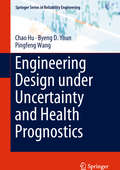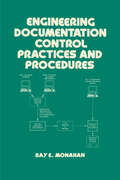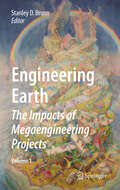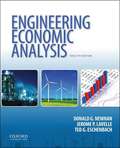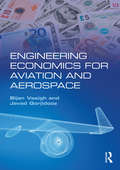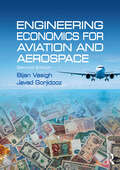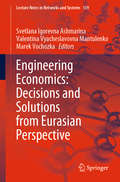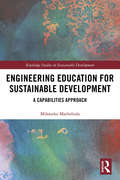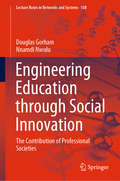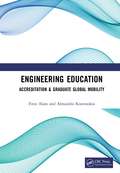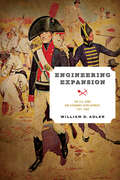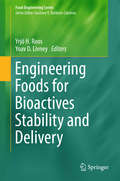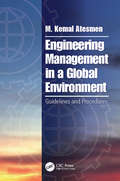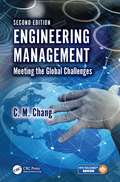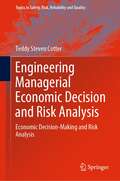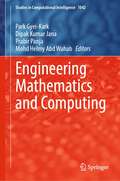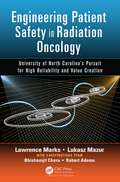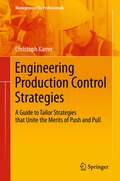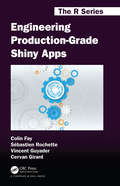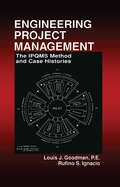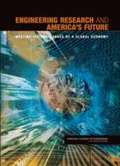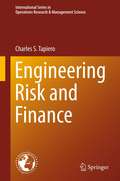- Table View
- List View
Engineering Design under Uncertainty and Health Prognostics (Springer Series in Reliability Engineering)
by Chao Hu Byeng D. Youn Pingfeng WangThis book presents state-of-the-art probabilistic methods for the reliability analysis and design of engineering products and processes. It seeks to facilitate practical application of probabilistic analysis and design by providing an authoritative, in-depth, and practical description of what probabilistic analysis and design is and how it can be implemented. The text is packed with many practical engineering examples (e.g., electric power transmission systems, aircraft power generating systems, and mechanical transmission systems) and exercise problems. It is an up-to-date, fully illustrated reference suitable for both undergraduate and graduate engineering students, researchers, and professional engineers who are interested in exploring the fundamentals, implementation, and applications of probabilistic analysis and design methods.
Engineering Documentation Control Practices & Procedures
by Ray E. MonahanDiscusses the requirements for establishing, maintaining and revitalizing an efficient engineering documentation control system for use by technical and manufacturing personnel in private industry. The book stresses simplicity and common sense in the development and implementation of all control practices, procedures and forms. A list of effective
Engineering Earth: The Impacts of Megaengineering Projects
by Stanley D. BrunnThis is the first book to examine the actual impact of physical and social engineering projects in more than fifty countries from a multidisciplinary perspective. The book brings together an international team of nearly two hundred authors from over two dozen different countries and more than a dozen different social, environmental, and engineering sciences. Together they document and illustrate with case studies, maps and photographs the scale and impacts of many megaprojects and the importance of studying these projects in historical, contemporary and postmodern perspectives. This pioneering book will stimulate interest in examining a variety of both social and physical engineering projects at local, regional, and global scales and from disciplinary and trans-disciplinary perspectives.
Engineering Economic Analysis
by Donald G. Newnan Jerome P. Lavelle Ted G. EschenbachThe twelfth edition of the market-leading Engineering Economic Analysis offers comprehensive coverage of financial and economic decision making for engineers, with an emphasis on problem solving, life-cycle costs, and the time value of money. The authors' concise, accessible writing, practical emphasis, and contemporary examples linked to students' everyday lives make this text the most popular among students. In addition, with its extensive support package and logical progression of topics, this is the easiest book to teach from.
Engineering Economics for Aviation and Aerospace
by Bijan Vasigh Javad GorjidoozFor all engineers and practitioners, it is essential to have a fundamental understanding of cost structure, estimating cash flows, and evaluating alternative projects and designs on an economic basis. Engineering Economics for Aviation and Aerospace provides the tools and techniques necessary for engineers to economically evaluate their projects and choices. The focus of this book is on a comprehensive understanding of the theory and practical applications of engineering economics. It explains and demonstrates the principles and techniques of engineering economics and financial analysis as applied to the aviation and aerospace industries. Time value of money, interest factors, and spreadsheet functions are used to evaluate the cash flows associated with a single project or multiple projects. The alternative engineering economics tools and techniques are utilized in separate chapters to evaluate the attractiveness of a single project or to select the best of multiple alternatives. Most of the engineering economics and financial mathematics books available in the market take either a pure theoretical approach or offer limited applications. This book incorporates both approaches, providing students of aviation and industrial economics, as well as practitioners, with the necessary mathematical knowledge to evaluate alternatives on an economic basis.?
Engineering Economics for Aviation and Aerospace
by Bijan Vasigh Javad GorjidoozIt is essential for all engineers and practitioners to have a fundamental understanding of cost structure, estimating cash flows, and evaluating alternative projects and designs on an economic basis. Engineering Economics for Aviation and Aerospace provides the tools and techniques necessary for engineers to economically evaluate their projects and choices.Offering a comprehensive understanding of the theory and practical applications of engineering economics, this book explains and demonstrates the principles and techniques of engineering economics and financial analysis as applied to the aviation and aerospace industries. The authors use time value of money, interest, and Microsoft Excel functions to evaluate the cash flows associated with a single project or multiple projects. They use different engineering economics tools to evaluate individual projects or select the best of multiple alternatives.Fully updated to reflect the latest information on, and practical insights into, the field of engineering economics, this second edition of Engineering Economics for Aviation and Aerospace continues to provide students of aviation and industrial economics, as well as practitioners, with the necessary mathematical knowledge to evaluate alternatives on an economic basis.
Engineering Economics: Decisions and Solutions from Eurasian Perspective (Lecture Notes in Networks and Systems #139)
by Marek Vochozka Svetlana Igorevna Ashmarina Valentina Vyacheslavovna MantulenkoThis book presents the outcomes of the annual “Engineering Economics Week – 2020,” organized by the Russian Union of Industrialists and Entrepreneurs, the Institute of Management and the Institute of Market Problems of the Russian Academy of Sciences (RAS), the South-Russian State Polytechnic University and Samara State University of Economics, and held in online format in May 2020. Focusing on the following topics: - the globalized economy and Russian industrial enterprises: development specifics and international co-operation;- state support for the real sector of the economy;- decisions in production and project management in the context of the digital economy;- big data and big challenges in production networks and systems ; and- economic and social aspects of the innovation management: decision-making and control this book will appeal to scientists, teachers and students (bachelor’s, master’s and postgraduate) at higher education institutions, economists, specialists at research centers, managers of industrial enterprises, business professionals, and those at media centers, and development fund and consulting organizations.
Engineering Education for Sustainable Development: A Capabilities Approach (Routledge Studies in Sustainable Development)
by Mikateko MathebulaThis book demonstrates how the theoretical concepts of the capabilities approach can be applied in the context of engineering education, and how this could be used to add nuance to our understanding of the contribution higher education can make to human flourishing. In demonstrating the usefulness of the capability approach as a lens through which to evaluate the outputs of engineering education, the author also shows how the capability approach can be informed by, and informs, the concept of ‘sustainable development’ and discusses what pedagogical and curricula implications this may have for education for sustainable development (ESD), particularly in engineering. As such, the book builds on the work of scholars of engineering education, and scholars of university education at the nexus of development and sustainability. Engineering employers, educators and students from diverse contexts discuss both the capabilities and functions that are enlarged by engineering education and the impact these can have on pro-poor engineering or public-good professionalism. The book therefore makes an original conceptual and empirical contribution to our thinking about engineering education research. The book provides inspiration for both engineering educators and students to orient their technical knowledge and transferable skills towards the public good. It will also be of great interest to students and researchers interested in education for sustainable development more generally and to engineers who are interested in doing work that is aligned with the goals of social justice. The book will also appeal to scholars of the capability approach within higher education.
Engineering Education through Social Innovation: The Contribution of Professional Societies (Lecture Notes in Networks and Systems #108)
by Douglas Gorham Nnamdi NwuluThis book explores the nexus between professional technical societies and engineering education by examining several societies’ efforts to promote and support engineering and engineering education in the areas of pre-university education, university education and informal education through programs and activities designed to leverage social innovation. Professional societies are in a unique position to support and contribute to engineering education, and have dedicated substantial resources to social responsibility programs and activities that promote engineers and engineering. The book is chiefly intended for engineers, engineering educators, staff members of professional technical societies, and for the broad range of scholars whose work involves technology education and education policy.
Engineering Education: Accreditation & Graduate Global Mobility
by Firoz Alam Alexandra KootsookosThis book details the key concepts, objectives and processes relating to the professional accreditation of engineering bachelor (honours) degrees. The contemporary context of accreditation is examined in terms of the globalised nature of both the engineering profession and higher education. Examples of the processes relating to single and dual accreditation are provided, with examination of the Washington Accord and the requirements of the European Network for Accreditation of Engineering Education. Details are also provided as to how learning outcomes can be structured to demonstrate compliance with accreditation criteria. The final chapters deal briefly with quality assurance processes used in education and the current international quality ranking systems which exist. This book will provide the reader with a detailed examination of outcome based education within the context of Bachelor of Engineering (honours) degrees. A key feature of this book is the side-by-side comparison of different accreditation criteria and a thorough discussion of the relatively new phenomenon of dual accreditation. The book seeks to provide a very clear explanation and exploration of accreditation within the context of engineering education and will benefit those practitioners involved in the accreditation process.
Engineering Entrepreneurship from Idea to Business Plan
by Paul SwamidassThis book is for engineers and scientists who have the aptitude and education to create new products that could become income-producing businesses for themselves and for investors. The book uses short chapters and gets directly to the point without lengthy and distracting essays. The rapid growth in technology-based business plan contests is a clear sign that there are many wealthy inventors looking to make substantial investments in start-ups. The key features of this reference enable readers to sharpen their new idea, turn an idea into a commercial product, conduct patent search and complete a provisional patent application, collect requisite data and prepare a business model, and prepare a business plan. The material presented can be used in a college course with teams made of three or four students per team or for self-study. Supporting materials are provided on the book's website (www. engineer-entrepreneur-book. com/).
Engineering Expansion: The U.S. Army and Economic Development, 1787-1860 (American Governance: Politics, Policy, and Public Law)
by William D. AdlerEngineering Expansion examines the U.S. Army's role in U.S. economic development from the nation's founding to the eve of the Civil War. William D. Adler starts with a simple question: if the federal government was weak in its early years, how could the economy and the nation have grown so rapidly?Adler answers this question by focusing on the strongest part of the early American state, the U.S. Army. The Army shaped the American economy through its coercive actions in conquering territory, expanding the nation's borders, and maintaining public order and the rule of law. It built roads, bridges, and railroads while Army engineers and ordnance officers developed new technologies, constructed forts that encouraged western settlement and nurtured nascent communities, cleared rivers, and created manufacturing innovations that spread throughout the private sector. Politicians fought for control of the Army, but War Department bureaucracies also contributed to their own development by shaping the preferences of elected officials.Engineering Expansion synthesizes a wide range of historical material and will be of interest to those interested in early America, military history, and politics in the early United States.
Engineering Foods for Bioactives Stability and Delivery
by Yrjö H. Roos Yoav D. LivneyThis book introduces recovery and stabilization of common bioactive materials in foods as well as materials science aspects of engineering stable bioactive delivery systems. The book also describes most typical unit operations and processes used in recovery and manufacturing of food ingredients and foods with stabilized bioactive components. The 15 chapters of the book discuss in detail substances that need to be protected and delivered via foods and beverages to achieve good stability, bioavailability and efficacy. Dedicated chapters present current and novel technologies used for stabilization and delivery of bioactive components. The material included covers formulation, stability, digestive release, bioaccessability and bioavailability. The text features a special emphasis on the materials science and technological aspects required for stabilization and successful production of foods with bioactive components. Consumer demand for healthier, yet satisfying food products is posing increasingly tough challenges for the food industry. Scientific research reveals new bioactive food components and new functionalities of known components. Food materials science has also developed to a stage where food materials can be designed and produced to protect sensitive components for their delivery in complex food products. Such delivery systems must meet high safety and efficacy requirements and regulations, as well as economic viability criteria and consumer acceptance.
Engineering Legitimacy: How Institutional Entrepreneurs In E-commerce Bring Fashion Companies Into The Digital Age
by Iva PetkovaThrough the lens of the fashion industry, Iva Petkova explores not only how institutionalized organizations react and adapt to the rise of start-up outsiders, but also how these outside “disruptors” seek to cultivate legitimacy and win influence. In so doing, she reflects upon a longstanding question in the sociology of organizations and neo-institutional theory: How do institutionalized organizations in creative industries resolve the inherent conflict between art and commerce, particularly in a changing institutional environment? Engineering Legitimacy outlines the processes through which e-commerce and social commerce companies in fashion disturb and reconstruct the industry, crosscutting their technical field of expertise and looking to legitimize their innovative practice in the institutionally elaborated field of fashion. Through an analysis of the emerging culture of innovation collectively created by start-up outsider disruptors, this book contemplates how fashion-technology companies transform their moral narratives into acceptable commercial practice, legitimating a model of profound institutional change over the digital operations of fashion companies.
Engineering Management in a Global Environment: Guidelines and Procedures
by M. Kemal AtesmenIn today's global business environment with high speed interactions, engineering organizations are evolving continuously. Engineering Management in a Global Environment: Guidelines and Procedures provides guidelines for changing roles of engineering managers in the international arena. The book covers global, multidisciplinary, and flat engineering organizations. Recommended procedures for hiring, mentoring, work assignments, and meetings in the global arena are detailed. Guidelines for keeping up with technology and with the changing world, performance reviews, layoffs, necessary engineering tools, and work atmosphere are discussed. Procedures for engineering team building and for having good relationships with upper management, customers, subcontractors, and regulatory agencies are provided. Each chapter ends with a checklist summarizing engineering managerial guidelines in that chapter.
Engineering Management: Meeting the Global Challenges, Second Edition
by C. M. ChangEngineering Management: Meeting the Global Challenges prepares engineers to fulfill their managerial responsibilities, acquire useful business perspectives, and take on the much-needed leadership roles to meet the challenges in the new millennium. Value addition, customer focus, and business perspectives are emphasized throughout. Also underlined are discussions of leadership attributes, steps to acquire these attributes, the areas engineering managers are expected to add value, the web-based tools which can be aggressively applied to develop and sustain competitive advantages, the opportunities offered by market expansion into global regions, and the preparations required for engineering managers to become global leaders. The book is organized into three major sections: functions of engineering management, business fundamentals for engineering managers, and engineering management in the new millennium. This second edition refocuses on the new strategy for science, technology, engineering, and math (STEM) professionals and managers to meet the global challenges through the creation of strategic differentiation and operational excellence. Major revisions include a new chapter on creativity and innovation, a new chapter on operational excellence, and combination of the chapters on financial accounting and financial management. The design strategy for this second edition strives for achieving the T-shaped competencies, with both broad-based perspectives and in-depth analytical skills. Such a background is viewed as essential for STEM professionals and managers to exert a strong leadership role in the dynamic and challenging marketplace. The material in this book will surely help engineering managers play key leadership roles in their organizations by optimally applying their combined strengths in engineering and management.
Engineering Managerial Economic Decision and Risk Analysis: Economic Decision-Making and Risk Analysis (Topics in Safety, Risk, Reliability and Quality #39)
by Teddy Steven CotterThis book directs the engineering manager or the undergraduate student preparing to become an engineering manager, who is or will become actively engaged in the management of economic-risk trade-off decisions for engineering investments within an organizational system. In today’s global economy, this may mean managing the economic risks of engineering investments across national boundaries in international organizations, government, or service organizations. As such, this is an applied book. The book’s goal is to provide an easy to understand, up to date, and coherent treatment of the management of the economic-risk trade-offs of engineering investments. This book accomplishes this goal by cumulatively sequencing knowledge content from foundational economic and accounting concepts to cost estimating to the traditional engineering economics knowledge culminating in fundamental engineering managerial economic decision-making incorporating risk into engineering management economic decisions.
Engineering Mathematics and Computing (Studies in Computational Intelligence #1042)
by Dipak Kumar Jana Park Gyei-Kark Prabir Panja Mohd Helmy Abd WahabThis book contains select papers presented at the 3rd International Conference on Engineering Mathematics and Computing (ICEMC 2020), held at the Haldia Institute of Technology, Purba Midnapur, West Bengal, India, from 5–7 February 2020. The book discusses new developments and advances in the areas of neural networks, connectionist systems, genetic algorithms, evolutionary computation, artificial intelligence, cellular automata, self-organizing systems, soft computing, fuzzy systems, hybrid intelligent systems, etc. The book, containing 19 chapters, is useful to the researchers, scholars, and practising engineers as well as graduate students of engineering and applied sciences.
Engineering Patient Safety in Radiation Oncology: University of North Carolina's Pursuit for High Reliability and Value Creation
by Robert Adams Lukasz Mazur Lawrence Marks Bhishamjit CheraBecause radiation is a central curative and palliative therapy for many patients, it is essential to have safe and efficient systems for planning and delivering radiation therapy. Factors such as rapid technological advances, financial reorganization, an aging population, and evolving societal expectations, however, may be compromising our ability
Engineering Production Control Strategies
by Christoph KarrerIdentifying and customizing suitable control strategies is a challenging task, especially when production systems have to cope with variable demands, forecast error, and unstable processes. The focus of this book lies on helping companies with complex and discrete production systems to tailor a production control strategy to their needs. Thereby, the mutual merits of "push" and "pull" systems are taken into account, leading to hybrid strategies. Consequently, the book addresses practitioners who are interested in looking behind the scenes and into the physics of production control. A real-life case study demonstrates the practical applicability of the presented framework.
Engineering Production-Grade Shiny Apps (Chapman & Hall/CRC The R Series)
by Colin Fay Sébastien Rochette Vincent Guyader Cervan GirardFrom the Reviews "[This book] contains an excellent blend of both Shiny-specific topics … and practical advice from software development that fits in nicely with Shiny apps. You will find many nuggets of wisdom sprinkled throughout these chapters…." Eric Nantz, Host of the R-Podcast and the Shiny Developer Series (from the Foreword) "[This] book is a gradual and pleasant invitation to the production-ready shiny apps world. It …exposes a comprehensive and robust workflow powered by the {golem} package. [It] fills the not yet covered gap between shiny app development and deployment in such a thrilling way that it may be read in one sitting…. In the industry world, where processes robustness is a key toward productivity, this book will indubitably have a tremendous impact." David Granjon, Sr. Expert Data Science, Novartis Presented in full color, Engineering Production-Grade Shiny Apps helps people build production-grade shiny applications, by providing advice, tools, and a methodology to work on web applications with R. This book starts with an overview of the challenges which arise from any big web application project: organizing work, thinking about the user interface, the challenges of teamwork and the production environment. Then, it moves to a step-by-step methodology that goes from the idea to the end application. Each part of this process will cover in detail a series of tools and methods to use while building production-ready shiny applications. Finally, the book will end with a series of approaches and advice about optimizations for production. Features Focused on practical matters: This book does not cover Shiny concepts, but practical tools and methodologies to use for production. Based on experience: This book is a formalization of several years of experience building Shiny applications. Original content: This book presents new methodologies and tooling, not just a review of what already exists. Engineering Production-Grade Shiny Apps covers medium to advanced content about Shiny, so it will help people that are already familiar with building apps with Shiny, and who want to go one step further.
Engineering Project Management: The IPQMS Method and Case Histories (Van Nostrand Reinhold Environmental Engineering Ser.)
by Louis GoodmanThis book presents IPQMS (Integrated Planning and Quality Management System) as a powerful management methodology. This system ensures cost-effectiveness as well as quality in the constructed project, environmental cleanups, and other sectors - providing an integrative force for essential teamwork in industry and government. This book contains business and engineering case studies, illustrating a principle, issue, or approach in making a decision. Each case study examines the spectrum of a particular project, demonstrating the interrelationships among policy makers, planners, designers, implementers, and managers in creating a project.
Engineering Psychology and Cognitive Ergonomics: Volume 1: Transportation Systems (Engineering Psychology And Cognitive Ergonomics Ser. #Vol. 4)
by Don HarrisThis is the first of two edited volumes from an international group of researchers and specialists, which together comprise the edited proceedings of the First International Conference on Engineering Psychology and Cognitive Ergonomics, organized by Cranfield College of Aeronautics at Stratford-upon-Avon, England in October 1996. The applications areas include aerospace and other transportation, human-computer interaction, process control and training technology. Topics addressed include: the design of control and display systems; human perception, error, reliability, information processing, and human perception, error, reliability, information processing, and awareness, skill acquisition and retention; techniques for evaluating human-machine systems and the physiological correlates of performance. This volume covers Human Factors in transportation systems. Part One opens with a chapter by Chris Wickens on attentional issues in head-up displays; its concluding chapter by Peter Jorna, pulls together the Human Factors issues in air traffic management from both the pilot‘s and the air traffic controller‘s perspectives. Part Two considers the ground-based aspects to air traffic control, while Part Three emphasizes the psychology of the individual. The opening chapter of Part Four uses lessons learned from aviation to avoid similar mistakes in road vehicles. The final part contains topics such as naval command and control, and automation in trains and armoured fighting vehicles.
Engineering Research And America's Future: Meeting The Challenges Of A Global Economy
by Committee to Assess the Capacity of the U.S. Engineering Research EnterpriseLeadership in innovation is essential to U.S. prosperity and security. In a global, knowledge-driven economy, technological innovation—the transformation of new knowledge into products, processes, and services of value to society—is critical to competitiveness, long-term productivity growth, and an improved quality of life. Preeminence in technological innovation depends on a wide array of factors, one of which is leadership in engineering research, education, and practice. A threedecade- long decline in the share of federal investment in research and development devoted to engineering and a perceived erosion of basic, long-term engineering research capability in U.S. industry and federal laboratories have raised serious questions about the long-term health of engineering research in the United States. This book illustrates the critical role of engineering research in maintaining U.S. technological leadership; documents major challenges and opportunities facing the U.S. engineering research enterprise; and offers specific recommendations for leaders in federal and state government, industry, and universities to help strengthen U.S. engineering research in the face of intensifying global competition.
Engineering Risk and Finance
by Charles S. TapieroRisk models are models of uncertainty, engineered for some purposes. They are "educated guesses and hypotheses" assessed and valued in terms of well-defined future states and their consequences. They are engineered to predict, to manage countable and accountable futures and to provide a frame of reference within which we may believe that "uncertainty is tamed". Quantitative-statistical tools are used to reconcile our information, experience and other knowledge with hypotheses that both serve as the foundation of risk models and also value and price risk. Risk models are therefore common to most professions, each with its own methods and techniques based on their needs, experience and a wisdom accrued over long periods of time. This book provides a broad and interdisciplinary foundation to engineering risks and to their financial valuation and pricing. Risk models applied in industry and business, heath care, safety, the environment and regulation are used to highlight their variety while financial valuation techniques are used to assess their financial consequences. This book is technically accessible to all readers and students with a basic background in probability and statistics (with 3 chapters devoted to introduce their elements). Principles of risk measurement, valuation and financial pricing as well as the economics of uncertainty are outlined in 5 chapters with numerous examples and applications. New results, extending classical models such as the CCAPM are presented providing insights to assess the risks and their price in an interconnected, dependent and strategic economic environment. In an environment departing from the fundamental assumptions we make regarding financial markets, the book provides a strategic/game-like approach to assess the risk and the opportunities that such an environment implies. To control these risks, a strategic-control approach is developed that recognizes that many risks resulting by "what we do" as well as "what others do". In particular we address the strategic and statistical control of compliance in large financial institutions confronted increasingly with a complex and far more extensive regulation.
